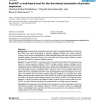102 search results - page 12 / 21 » Using constraint programming for lattice protein folding |
CONSTRAINTS
2008
13 years 7 months ago
2008
Bioinformatics aims at applying computer science methods to the wealth of data collected in a variety of experiments in life sciences (e.g. cell and molecular biology, biochemistry...
BMCBI
2006
13 years 7 months ago
2006
Background: The functional annotation of proteins relies on published information concerning their close and remote homologues in sequence databases. Evidence for remote sequence ...
BMCBI
2006
13 years 7 months ago
2006
Background: In the area of protein structure prediction, recently a lot of effort has gone into the development of Model Quality Assessment Programs (MQAPs). MQAPs distinguish hig...
SSDBM
2003
IEEE
14 years 1 months ago
2003
IEEE
Life science researchers frequently need to query large protein data sets in a variety of different ways. Protein data sets have a rich structure that includes its primary structu...
ISMB
2000
13 years 9 months ago
2000
Knowing the number of residue contacts in a protein is crucial for deriving constraints useful in modeling protein folding, protein structure, and/or scoring remote homology searc...

